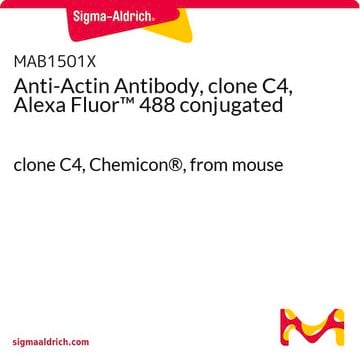MAB1501
Anti-Actin Antibody, clone C4
ascites fluid, clone C4, Chemicon®
Synonym(s):
MAB1501X, MAB1501R, Pan Actin antibody
About This Item
Recommended Products
biological source
mouse
Quality Level
antibody form
ascites fluid
antibody product type
primary antibodies
clone
C4, monoclonal
species reactivity (predicted by homology)
all
manufacturer/tradename
Chemicon®
technique(s)
ELISA: suitable
immunocytochemistry: suitable
immunofluorescence: suitable
immunohistochemistry (formalin-fixed, paraffin-embedded sections): suitable
western blot: suitable
isotype
IgG2bκ
NCBI accession no.
UniProt accession no.
target post-translational modification
unmodified
Gene Information
human ... ACTA1(58)
General description
Specificity
Immunogen
Application
Tissue culture cells -- fix with formaldehyde, treat with methanol or acetone.
Glycerinated myofibrils -- fix fibers with formaldehyde, treat with cold methanol. Stains I-bands intensely and stress fibers in human fibroblasts.
Cryostat sections (6 µm) -- quick frozen in isopentane, slides treated with gelatin and formaldehyde.
Immunoblots:
1:100-1:1,000 (Otey, 1987):On muscle homogenates subject to SDS-PAGE, reacts relatively uniformly with a 43 kD protein present in skeletal, cardiac, gizzard and aorta tissues. Appears to react with all isoforms of actin found in these preparations and shows a strong reaction with the alpha-actin found in skeletal, cardiac, and arterial muscle.
Iodination (Lessard, 1979).
Solid phase binding assay ELISA:
1:800-1:1,000 dilution from a previous lot was shown to be strongly reactive with cytoplasmic actin and shows a significant binding to gizzard, skeletal, arterial and cardiac actins. Also shows a significant binding to both Dictyostelium discoidum and Physarum polycephalum.
ELISA:
strongly reactive with the cytoplasmic actin and shows a significant binding to gizzard, skeletal, arterial and cardiac actins. Also shows a significant binding to both Dictyostelium discoidum and Physarum polycephalum.
Optimal working dilutions must be determined by end user.
Cell Structure
Cytoskeletal Signaling
Quality
Western Blot Analysis:
1:500 dilution of this lot detected ACTIN on 10 ug of A431 lysates.
Target description
Linkage
Physical form
Storage and Stability
Analysis Note
HeLa whole cell lysate.
Legal Information
Disclaimer
Not finding the right product?
Try our Product Selector Tool.
recommended
Storage Class Code
10 - Combustible liquids
WGK
WGK 1
Flash Point(F)
Not applicable
Flash Point(C)
Not applicable
Certificates of Analysis (COA)
Search for Certificates of Analysis (COA) by entering the products Lot/Batch Number. Lot and Batch Numbers can be found on a product’s label following the words ‘Lot’ or ‘Batch’.
Already Own This Product?
Find documentation for the products that you have recently purchased in the Document Library.
Customers Also Viewed
Articles
Immunofluorescence uses antibody-conjugated fluorescent molecules for protein localization, modification confirmation, and protein complex visualization.
Protocols
Tips and troubleshooting for FFPE and frozen tissue immunohistochemistry (IHC) protocols using both brightfield analysis of chromogenic detection and fluorescent microscopy.
Our team of scientists has experience in all areas of research including Life Science, Material Science, Chemical Synthesis, Chromatography, Analytical and many others.
Contact Technical Service















